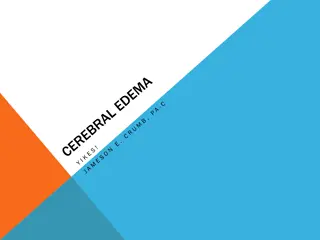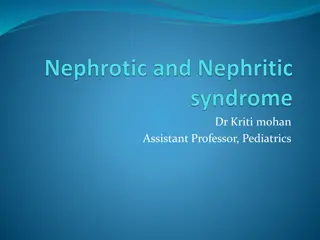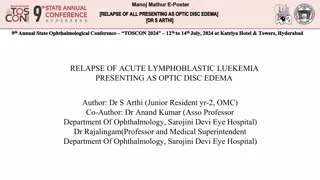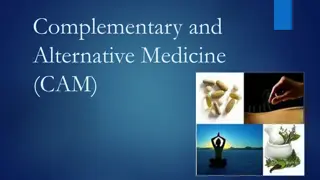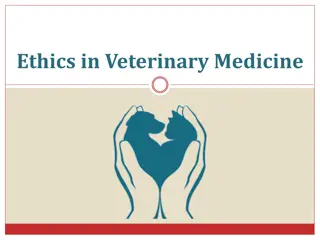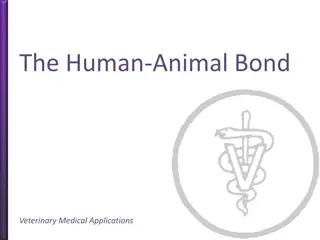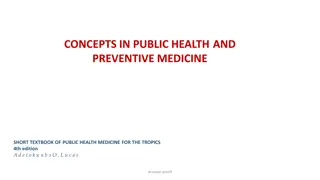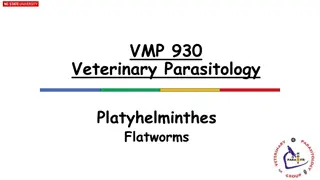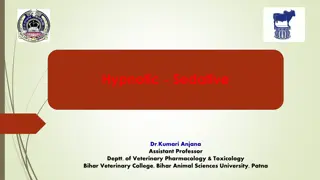Understanding Edema in Veterinary Medicine
Edema, an excessive accumulation of fluid in tissue spaces, is caused by disruptions in fluid exchange mechanisms. It can result from various factors such as increased hydrostatic pressure, decreased plasma oncotic pressure, increased capillary permeability, and obstruction to lymphatic flow. Different etiologies lead to specific types of edema, with manifestations ranging from local to systemic. Understanding the underlying causes and pathogenesis of edema is crucial for effective veterinary management.
Uploaded on Sep 15, 2024 | 0 Views
Download Presentation

Please find below an Image/Link to download the presentation.
The content on the website is provided AS IS for your information and personal use only. It may not be sold, licensed, or shared on other websites without obtaining consent from the author. Download presentation by click this link. If you encounter any issues during the download, it is possible that the publisher has removed the file from their server.
E N D
Presentation Transcript
OEDEMA Unit- 1(General), Veterinary Medicine Dr. Anil Kumar Asst. professor, VCC, BVC (BASU), PATNA
Edema Edema is the excessive accumulation of fluid in the interstitial space of tissue caused by a disturbance in the mechanism of fluid interchange between capillaries, the interstitial space and the lymphatic vessels ETIOLOGY: Edema results from four causes: I. Increased hydrostatic pressure in capillaries and veins due to chronic CHF or obstruction to venous return; II. Decreased plasma oncotic pressure III. Increased capillary permeability in endotoxemia, part of the allergic response, vasculitis and damage to the vascular endothelium; or IV. Obstruction to lymphatic flow
Increased hydrostatic pressure: Symmetric ventral edema in chronic (congestive) heart failure, symmetric pulmonary edema in acute heart failure Enzootic calcinosis of cattle udder edema in late pregnancy Local edema by compressive lesions on veins (as in thymic lymphosarcoma with compression of the cranial vena cava) draining other anatomic locations Local edema in portal hypertension due to hepatic fibrosis causing ascites
Decreased plasma oncotic pressure: Decreased total protein concentration in plasma, and particularly decreased plasma albumin concentration, will result in symmetric ventral edema Hypoalbuminemia can result from increased loss (due to bloodsucking parasites or across the gastrointestinal tract, kidneys or into a large third space such as the pleural or peritoneal cavities), decreased production (as in chronic hepatic failure) or decreased intake
Increased capillary permeability: Endotoxemia Allergic edema as in urticaria and angioneurotic edema caused by local liberation of vasodilators Toxic damage to vascular endothelium or vasculitis - in anthrax, gas gangrene and malignant edema in ruminants, edema disease of pigs, mulberry heart disease in pigs, equine viral arteritis, equine infectious anemia, purpura hemorrhagica in horses, and heartwater (cowdriosis) in ruminants
Obstruction to lymphatic flow: Part of the edema caused by tumors or inflammatory swellings is lymphatic obstruction. Extensive fluid loss also originates from granulomatous lesions on serous surfaces. Ascites or hydrothorax may result PATHOGENESIS: At the arteriolar end of the capillaries the hydrostatic pressure of the blood is sufficient to overcome its oncotic pressure and fluid tends to pass into the interstitial space At the venous end of the capillaries the position is reversed and fluid tends to return to the vascular system
CLINICAL FINDINGS: Anasarca (Accumulation of edematous transudate in subcutaneous tissues) Ascites (Accumulation of edematous transudate in peritoneal cavity) Hydrothorax Hydropericardium Swellings are soft, painless and cool to the touch, and pit on pressure In ascites there is distension of the abdomen and the fluid can be detected by a fluid thrill on tactile percussion, fluid sounds on succussion and by paracentesis
In the pleural cavities and pericardial sac The clinical signs include restriction of cardiac movements, embarrassment of respiration and collapse of the ventral parts of the lungs. Muffled heart sounds and respiratory sounds are, and the presence of fluid may be ascertained by percussion and thoracocentesis or pericardiocentesis More localized edemas cause more localized signs: Pulmonary edema -respiratory distress Cerebral edema-nervous signs Thrombophlebitis- Head edema due to complete occlusion of both jugular veins
CLINICAL PATHOLOGY: Cytological examination for absence of inflammatory cells Thoracocentesis or abdominocentesis is useful to differentiate the causes of fluid accumulation Serum albumin concentration and central venous pressures Hypoalbuminemia-determine renal and gastrointestinal systems and liver
TREATMENT: Correcting the cause Chronic (congestive) heart failure may need to be treated with digoxin Hypoalbuminemia may require the administration of plasma or plasma substitutes Ancillary nonspecific measures: Restriction of the amount of salt in the diet Use of diuretics


